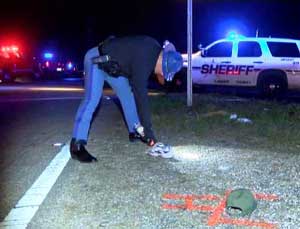Union Co. responder training goal: work traffic incidents safely
Union County Emergency Responders are introduced to the National Traffic Incident Management Responder Training Program issued by Congress, which authorized the SHRP 2 (second Strategic Highway Research Program) in 2005. SHRP 2 is designed to investigate the underlying causes of highway crashes and congestion in a short-term program of focused research for safety, reliability, renewal, and capacity. This group developed a document referred to as the National Unified Goal (NUG) for Traffic Incident Management (TIM). This program has three main objectives, and they are: 1) responder safety, 2) safe, quick clearance, 3) Prompt, reliable, interoperable communications.
 This responder training class is offered through the State, and is mandatory for all fire, law enforcement, towing companies, and other emergency responders. On any given typical year, there are 12 law enforcement officers, 5 fire and rescue personnel, 60 towing and recovery professionals, and several DOT, public works, and safety service patrol workers struck and killed on our nation’s roadways.
This responder training class is offered through the State, and is mandatory for all fire, law enforcement, towing companies, and other emergency responders. On any given typical year, there are 12 law enforcement officers, 5 fire and rescue personnel, 60 towing and recovery professionals, and several DOT, public works, and safety service patrol workers struck and killed on our nation’s roadways.
“This year alone, I have attended two funerals/visitations for firefighters killed while working an incident on the highway in the southern part of the state. I have also documented incidents with pictures of drivers, either under the influence or distracted driving, running through our incident scenes here in New Albany and Union County. It is a bad problem, and the public just doesn’t realize how often it happens. I have seen it happen more times than I would like to recall, and I have heard way too many tires screeching–trying to stop to keep from hitting us or our victims,” stated Deputy Chief Mark Whiteside.
 In this program, responders are taught where and how to park on the roadways, how to block traffic properly, where to park support vehicles, ambulances, law enforcement vehicles, tow trucks, and how to quickly and efficiently clear the incident areas.
In this program, responders are taught where and how to park on the roadways, how to block traffic properly, where to park support vehicles, ambulances, law enforcement vehicles, tow trucks, and how to quickly and efficiently clear the incident areas.
“The quicker we can clean it up, move it out of the way, and open the road up 100%, the less likely we are to have a secondary accident or incident. Our NUMBER 1 goal and objective is to protect our emergency responders and victims in these incidents, and we will do so to our fullest abilities SAFELY.
“This is the third year for this program. All we are working towards is to remind our responders of the basics, what is recommended to keep our incident scenes safe, and how to work side by side with all other agencies in a harmonious atmosphere to reach the same unified goal. That goal is for each and every person to arrive to the scene safely, remain safe while working the incident, and be able to return home safely afterwards,” stated Whiteside.














Leave a Reply
Want to join the discussion?Feel free to contribute!